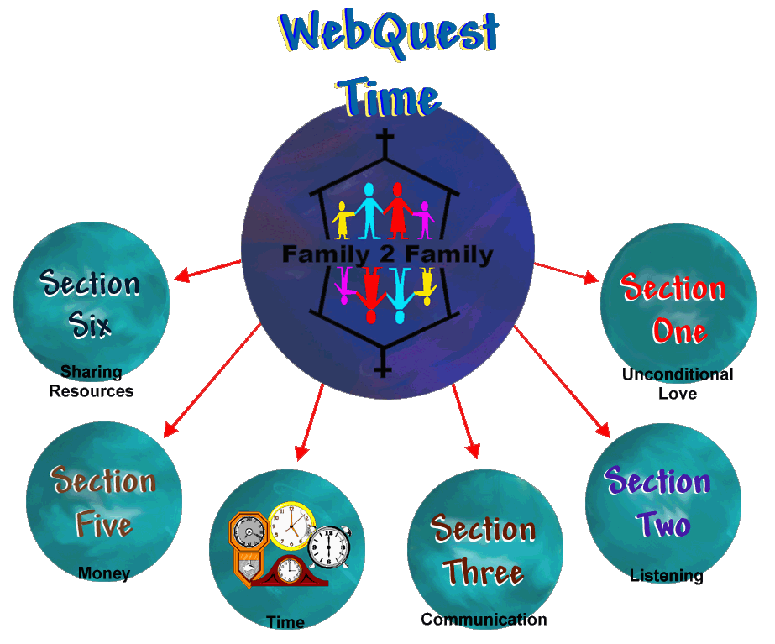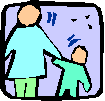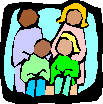How
Do You Make Time For Others?
Family
activities don't have to be elaborate, expensive planned out ideas.
Sometimes, simple is better. Just be willing to give your time and
attention, and don't forget the simple things in life.
|
Your
Task
1.
In a mentoring team, discussion is essential. Allow each member
to share ideas during each step of the WebQuest process.
2.
During this study you will be discussing time management for the
family.
3.
Follow the six process steps.
Step
1 - Learn about the family history.
Step
2 - Read the case study and answer the reflection questions.
Step
3 - Produce a Problem Statement and add it to the Discussion/Communication
box to share what you have done with others.
Step
4 - Use the Links to go on a WebQuest to research on the web.
Step
5 - Produce a Hypothesis and use the Discussion/Communication
box to share what you have come up with.
Step
6 - Finally, use the Discussion/Communication box again to
reflect and share on the learning experience.
|
Step 1: Learn about a family
Pick
a family from the choices linked on the family history page
and learn about a family, their history and all the struggles
they are currently facing.
|
Read
a case study from one of the following categories that match the
family history that you read from Step 1
Create
a list on a piece of paper under the heading: "What do we know?"
This may include data from the family history, the case study, or
information based on prior knowledge.
|
|
STEP
1 | STEP
2 | STEP
3 | STEP 4 | STEP
5 | STEP 6
Step
3: Develop a Problem Statement
A
problem statement should come from your analysis of what you know.
The problem statement will probably have to be refined as new information
is discovered and brought to bear on the situation. Typical problem
statements may be based on discrepant events, incongruities, anomalies,
or stated needs of the family.
Need
Help? View Problem Statement
Helps
"What
is this families problem"
Problem
Statement Discussion Boards
Enter
The Family Life Curriculum Forum and submit your problem
statement on the discussion page.

|
|

|
|

|
|

Forum
Rules:
1.
You must log on by creating a user name and password.
2.
Each group should maintain the same user name to enable
discussion consistency.
3.
You may not use the discussion boards for sales or advertisements.
4.
You may not use profanity.
5.
Respect and courtesy for others is required.
|
|
List
on paper what is needed for your family. Presented with the problem,
you will need to find information on this topic to research family
issues. Make a second list on your paper under the heading: "What
do we need to know?" These questions will guide searches that
will take place on-line.
|
Step
5: Formulate a hypothesis
Under
the heading: "What should we do?" list actions that may
be taken, recommendations and solutions.
Need
Help? View Hypothesis Helps
"What
should we do?"
Hypothesis
Statement Discussion Boards
Enter
The Family Life Curriculum Forum and submit your hypothesis
statement on the discussion page.

|
|

|
|

|
|

Forum
Rules:
1.
You must log on by creating a user name and password.
2.
Each group should maintain the same user name to enable
discussion consistency.
3.
You may not use the discussion boards for sales or advertisements.
4.
You may not use profanity.
5.
Respect and courtesy for others is required
|
|
STEP
1 | STEP
2 | STEP
3 | STEP 4 | STEP
5 | STEP 6
Step
6: Reflection and Sharing
As
part of reflection and sharing, present your findings and recommendations.
The presentation should bring together all the material gathered in
the previous steps. Analyze the problem statement, questions, data
gathered, analysis of data, and support for solutions and recommendations
based on other peoples comments in the discussion pages to make an
argument to support your solution.
Need
Help? View Reflection Helps
"Conclusion"
Reflection
Statement Discussion Boards
Enter
The Family Life Curriculum Forum and submit your reflection
statement on the discussion page.

|
|

|
|

|
|

Forum
Rules:
1.
You must log on by creating a user name and password.
2.
Each group should maintain the same user name to enable
discussion consistency.
3.
You may not use the discussion boards for sales or advertisements.
4.
You may not use profanity.
5.
Respect and courtesy for others is required.
|
|
Lets
see what we have learned!
We
often feel that we don't have the time or energy to extend ourselves
to others with the small gestures that compose what we call common
courtesy. It sometimes seems that this kind of social awareness
belongs to the past, when you were a newlywed, courting or when
you first fell in love. Yet, when you extend this kind of courtesy
to someone they always feel touched. When you lend a helping hand
when your spouse is struggling with the groceries it makes an impression
because you are taking the time from what you are doing to be considerate.
Even when you simply make the effort to look at your spouse in the
eye, smile, and say something supportive when you are unavailable
to physically help you are giving them your time. In this way you
can carry about yourself the elegance and grace of another time
and era. Common courtesy is a small gesture that makes a big difference.
|




